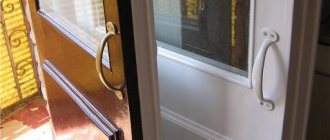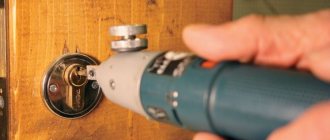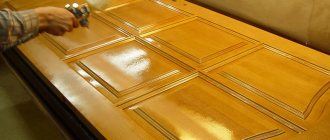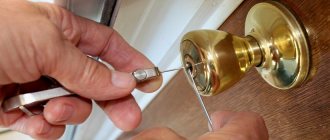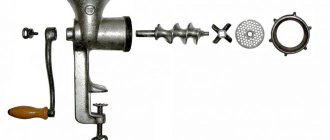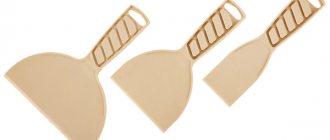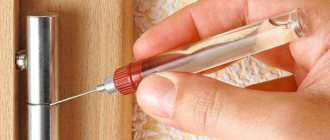Miscellaneous
During the off-season or in winter, owners of private houses are faced with the accumulation of moisture on the inside of the front door. At the same time, condensation on the front door may be insignificant, but sometimes it causes problems: water practically pours over the door leaf, handle and, even worse, over the lock. Because of this, puddles form inside the room, the door leaf deteriorates, and when there is severe frost outside, your own ice skating rink appears in the hallway.
No matter how you look at this problem, it in any case causes great inconvenience to the owners of a private house. There is, of course, a worse consequence of such a problem - the appearance of mold, which is then difficult to get rid of. Let's figure out why the front door sweats and how to get rid of condensation to avoid unpleasant consequences.
Condensation on a metal door
Causes of condensation accumulation
- The main reason why the front door “sweats” is an increase in air humidity. At the moment when the indicator exceeds 55%, moisture condenses on the surface of the door leaf in the place where the temperature is lower - at the “dew point”. In winter, the front door becomes such a point.
"Dew point"
Important! For a comfortable life for residents, and to avoid damage to the body by all kinds of diseases, maintain indoor air humidity within 45%. Humidity is affected by the operation of ventilation systems and average temperature.
- The problem with condensation in a private house appears due to poor sealing of the door leaf, especially if an iron door is installed. “Cold bridges” appear with increased thermal conductivity. Their typical places are the peephole, the handle, the pretend part. Here, condensation most often occurs on the entrance metal door, since heat transfer is increased.
"Bridges of Cold"
- Another reason why a door sweats is poor supply and exhaust ventilation in the room.
When equipping a room with metal-plastic windows or a steel door, installers rarely pay attention to supply and exhaust ventilation. However, initially incorrectly equipped ventilation or no ventilation leads to disastrous consequences, that is, to a sharp increase in humidity.
Supply and exhaust ventilation model
Many people simply do not need to think about air flow, and all because the door installed earlier was wooden and could independently provide ventilation and let in the required amount of air from the street.
Why does the door sweat and how to get rid of excess moisture: instructions for solving the problem
The accumulation of condensation on the surface of the front door is a common phenomenon that often affects owners of country houses. This negative manifestation must be eliminated as soon as possible after detection. A sweaty structure will not be able to properly protect the interior from the cold and will become unusable due to deformation and getting wet. Why do front doors sweat so often and how to deal with it?
- Causes of fogging
- What are the consequences of the phenomenon?
- Troubleshooting
- How to prevent fogging?
What to do when the front door gets wet due to condensation
In order not to solve the problem with a “crying” door after installation, think through all the nuances before starting installation:
- As we already know, condensation is formed due to the difference in temperature conditions inside and outside the room. Eliminate this factor by making a small unheated vestibule at the entrance.
- Equip an additional canopy or canopy over the door. In this case, the surface of the door leaf will not be exposed to direct sunlight, and there will not be a large temperature difference between the metal and the base, which will partially solve the problem.
- Choose doors with powder coating, which gives the surface additional weather resistance;
- Finish the outside of the canvas using decorative panels impregnated with a special compound that prevents condensation.
- To prevent the appearance of “cold bridges”, fill the voids in the metal door structure with polyurethane foam.
- Insulate the keyhole with a special pad. At the moment when the lock is not in use, it closes the hole, and to insert the key, it is moved back.
Keyhole cover
- Coating the door leaf with “liquid insulation”. The entrance metal door sweats due to temperature changes, with this manipulation you will avoid this problem and at the same time, by insulating the entrance to the room, you will save on heating.
Attention! A liquid thermal insulation suspension is applied to metal, wood, and plastic, like regular paint, and helps conserve heat and get rid of condensation.
When installing the door, the space that remains between the wall and the frame is filled with polyurethane foam. There is, of course, a box option, which is a metal pipe. In this case, holes are drilled in it and the cavity is filled with foam through them. In this case it plays the role of insulation.
Door frame made of metal pipes
Why does the front door still “cry”? The reason may also be due to the cladding on the side of the room. Because of it, heat does not pass to the metal sheet, and it does not heat up. If this finish is vapor-permeable, then condensation will form inside the door leaf, and you will know about it when the structure rusts.
How to get rid of condensation on a door?
To get rid of freezing and the formation of water droplets on the door, take into account exactly where the cold bridge appears.
If cold air and a small draft enters through the lock, then install a special cover with a moving lid on it, which will close the well and keep the cold out. To use the lock, you just need to move the cover to the side. This option will not be able to completely eliminate condensation, but will reduce its occurrence to a minimum.
How to prevent the problem
There are three ways to help prevent condensation if the door is metal. Let's look at them in more detail:
- Carefully check the structure during installation to ensure that there are no voids left between the frame and the wall. Even a small gap will lead to problems in the future. It is better to install the door efficiently from the very beginning, rather than disassemble the structure over time to eliminate the cause of condensation;
- Do not install a peephole and it is better to additionally insulate the keyhole;
- Do not purchase a product with vertical crossbars that will conduct cold air to the box in frosty weather.
Important! For additional heating, place heating devices near the entrance doors. Heating will dry the air and evaporate excess moisture. But do this in moderation, avoiding heating the door leaf.
If you do not neglect these tips and figure out the reasons from the very beginning, you can later avoid problems that will require dismantling the structure to eliminate. So we follow the rule - it’s better to do everything efficiently from the very beginning, rather than to redo it when first there seems to be minor condensation, and then just a stream of water on the front door.
Voted over 149 times, average rating 4.6
Comments
Chervatyuk Maria Pavlovna 05.11.201808:06 Condensation of the front door around the entire perimeter, what to do?
Grade
Svetlana 02/13/202018:45 Oh my God! As with windows with double glazing or double glazed windows! Are the doors leaking? The second doors are from the inside!!!! Wooden! Recessed and upholstered, as usual, foam rubber and dermantine!
Grade
Add a comment Cancel reply
We recommend reading
Miscellaneous How to choose the right door linings and install them yourself? When the renovation is completed, it still seems like something is missing. ...
Closer, Miscellaneous How does a front door closer work: device Until recently, in order for the door to close automatically, people ...
Miscellaneous Basic parameters and additional functions of handles for a Chinese entrance door If the handle on a Chinese entrance door is broken, replace it with...
Platbands, Miscellaneous The correct choice of platbands for installation on interior doors Refining defects or hiding them becomes the final...
Additional measures to combat condensation
If the recommendations described above did not help to avoid dampening the front door, then you can consider the option of coating the door with a special powder polymer. This is a type of paint that, due to its structure and method of application, gives the coating thermal insulation properties.
If you have to consider additional measures to combat moisture on metal, you should consider installing a second door (i.e. vestibule). The advantage of this solution is to reduce heat loss. Heat leaves the room less intensively due to the air space between the doors. As a result, condensation does not form on the front door. This measure allows you to get rid of moisture on the metal surface of the outer sash, provided that other recommendations for getting rid of excess moisture are taken into account.
Additional measures to combat condensation
As additional measures, the task of which is to finally get rid of drafts and thereby prevent the formation of condensation on the front door, two points can be noted.
- Insulation of external door slopes, if any. If not, then they may have to be made from polystyrene foam - naturally, it is better to provide for this moment when insulating the house, but if this is still far away, then you can start with the entrance group, and then do everything else. External blockage of the seam between the frame and the doorway will enhance the effect of insulating the internal slopes and additional foaming of the door block.
- Installation of a second wooden door, which will become an additional obstacle and will finally separate the warm air of the room from the cold surfaces of the entrance metal doors. Moreover, it will not only eliminate condensation on the metal entrance door, but will also make your home warmer, thereby reducing the cost of consumed energy resources.
Using electrical appliances to prevent condensation
Special electrical devices can also be used to combat condensation.
A thermal curtain is a device that provides a downward vertical air flow. An electric air curtain will help cut off air from the street when the door is opened. Warm air heats the door to the same level as the room temperature or even higher. However, this method has its drawbacks - the device is quite expensive, difficult to install and, moreover, leads to increased energy costs.
A device with a similar effect - a trench convector - differs in the direction of warm air. The air rises up and serves as the same thermal curtain. This device is considered the most effective, but has its drawbacks. First of all, this is the high cost of the device and the complexity of its installation (after all, a niche for such a convector must be laid out at the stage of major repairs). In addition, inclusion in the general heating system is required.
Installing a heating cable is much easier to implement. It goes deep into the wall around the perimeter of the front door using grooves. You can use a simple resistive heating wire, but then additional installation of a thermostat with a sensor will be required. To do without a thermostat, you need to use a self-heating cable. If desired, you can insert the cable inside the door frame itself, but then you will need to dismantle the structure and drill special holes. Therefore, this method is not used so often.
A more complicated version of the heating cable is laying a heating pipe. This is only possible at the stage of installing water heating throughout the house.
Preventing condensation
To get rid of condensation, you must first find the weak spot where air is leaking and cooling. There are several recommendations for competent work.
The reason may lie in insufficient or completely absent insulation of the joints. Air entering the cracks in these places greatly cools the metal and causes the release of water from the air. This means that to prevent the appearance of condensation, it is enough to lay a seal along the entire perimeter of the entrance metal door. Usually the sealant is applied independently - this is quite easy to do even for an inexperienced craftsman. It is preferable to use a rubber material where one side is adhesive. It is better to apply it first to the open door, and then move on to the door frame. These simple steps can reliably protect your front door from condensation.
Depending on the class of the door, its internal cavities may be filled with sealant or empty. The most commonly used heat-insulating materials are:
- mineral wool is the most heat-resistant material;
- polystyrene foam is the most affordable material;
- polyurethane foam is the most effective material.
It is much more difficult to deal with a problem if it occurs in a keyhole. Draft can enter through this small hole. The most reliable way is to simply fill the well with sealant. But if the door often opens and closes (for example, the entrance door), then this method will cause more inconvenience than benefit. An alternative would be a special pad that moves away only when the key is inserted into the hole. Such a detail may not completely prevent the formation of condensation, but it will significantly reduce the risk of its occurrence.
Why is freezing harmful?
A door that “sweats” will lead to the following consequences:
- The wood (if the structure has wooden parts) swells and swells, the edge comes off and decorative elements come off.
- Unpainted metal (if the paint is knocked off somewhere) rusts.
- When moisture appears on the lock, rust will form on it.
- Skewing the canvas or box leads to jamming of the lock.
- When a large amount of ice freezes on the canvas, the load on the hinges increases.
- The door does not open and close well due to the door being skewed.
- In the friction area (due to misalignment), the paint peels off.
- The frost that forms inside melts and flows onto the floor in the hallway.
- The freezing structure blows cold, so heating costs have to increase.
- The appearance deteriorates (finishing materials peel off).
- After particularly frosty nights, you may not be able to get into the house, as ice appears on the canvas and the box, and they freeze together.
Why is condensation dangerous?
Visually, a door with dripping drops of moisture does not look very aesthetically pleasing. When the surface freezes strongly, condensation turns into frost and ice. Condensation makes the air drier, worsening the indoor climate.
Draining moisture enters the keyhole or the lower grooves for the vertical anti-removal pins. If it freezes, you may find that the door simply cannot be opened.
Due to the moistening of the surface, corrosion, rust stains, fungus, and rotting of adjacent wooden parts of the structure form. You regularly have to wipe away any moisture that flows down and remove mold. However, any cleaning only eliminates the consequences; for effective control it is necessary to eliminate the cause.
The main reason for fogging of an iron door
The process of door fogging is the formation of condensation, the reason is a clearly expressed temperature difference between the air flows and the iron sheet, which contributes to a change in the state of aggregation of the water.
When water hits a hot iron piece, it evaporates. With the formation of condensation on the door, the situation is similar, only in the opposite direction - the water does not evaporate, but freezes. When condensation forms, water collected from air masses collects on the door. The reason for this situation lies in defects in the door insulation, or its complete absence. When the metal door to the street is not insulated at all, the problem is solved by filling the inside with insulation.
When the door is already insulated, but condensation still appears, it means the quality of the measures taken leaves much to be desired. It is enough to solve the issue of high-quality installation of insulation so that the door stops accumulating condensation. In other cases, sweating can be observed in the area where the lock part is located, as well as at the joints of the door and door frame. Perhaps the box itself is susceptible to fogging.
If the door is still sweating
This issue requires an urgent solution, since the longer you delay with the problem, the sadder the consequences will be. Sometimes sweating cannot be eliminated. Perhaps the situation is quite critical, or the doors themselves are of poor quality. In this case, they will need to be replaced. To do this, you should contact specialists who will offer reliable doors.
Professionals will also give recommendations for operation so that problems do not arise in the future. And most importantly, following the technology for installing a new door is a guarantee that it will not cry.
Several ways to prevent fogging
To be absolutely sure that sweating of the entrance metal door will not happen again, and also, in order to get rid of any drafts, you can take additional preventive measures:
- If there are door slopes on the street side, you need to insulate them . If there are no slopes, it is recommended to make them. It would be optimal to make slopes from foam plastic as part of the general work on insulating the house; if the procedure is carried out separately, the front door is insulated first, leaving the rest of the insulation work until a more appropriate time. It is recommended to seal the outside of the seam between the door opening and the frame and foam the door block.
- A second wooden entrance door installed additionally will completely prevent any cold from entering, creating an additional layer separating the street from the house. In this way, there is a complete separation of air masses from the street and warm air from the house. Neither drafts nor condensation will appear in the area where the metal door is located.
There is another unique way to get rid of fogging; the issue is solved by using a special paint that helps save energy. This material is also called liquid insulation, and is most often used to protect pipelines. A layer of such paint will prevent air from entering the cold metal surface. As a result, water will have nowhere to accumulate, which means the metal door will stop sweating.
Negative consequences of condensation
The answer to the question of why it is necessary to eliminate condensation as quickly as possible if it begins to form on the front door of a cottage or country house is quite simple. The fact is that the result of such a phenomenon is several extremely unpleasant consequences, in particular:
- The penetration of moisture into the entrance structure leads to a further, even more serious decrease in its operational parameters. As a result, the volume of condensate increases, and the product, primarily insulation and some types of decorative finishes, seriously lose, respectively, in efficiency and attractiveness;
- With constant exposure to moisture, corrosion is highly likely to occur, which sharply reduces the durability of the entire metal structure;
- Another unpleasant result is the formation of drafts or ice, which reduces the comfort of living and leads to poor health of residents, even leading to the onset of serious illnesses;
- Another, no less logical, consequence of this is an increase in the cost of heating the building, which in the conditions of the Russian climate and without the presence of condensation amounts to a very impressive amount.
The above negative consequences do not exhaust the list of possible troubles that the appearance of condensation promises homeowners. Obviously, in such a situation it is quite advisable to try to remove it as quickly as possible.
